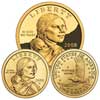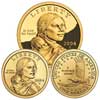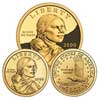Sacagawea (2000-2008)
Authorization for the Sacagawea Dollar came from the “United States Dollar Coin Act of 1997″ signed into law by President Clinton in December 1997. The visual appearance of the coins included within the legislation was the following: “The dollar coin shall be golden in color, have a distinctive edge, have tactile and visual features that make the denomination of the coin readily discernible…”
These stipulations seemed to be aimed at correcting the perceived shortcomings of the previous dollar coin series, which had been easily confused with other denominations. The golden color was achieved by using an alloy of managanese brass for the outer layer of the coin. The edge was plain, as opposed to reeded, and the coins had a wide rim around the circumference.
Glenna Goodacre created the obverse design for the Sacagawea Dollar. It features a portrait of Sacagawea, the Shoshone woman who accompanied Lewis and Clark on their expedition from 1804 to 1806. She is shown carrying her newborn son, Jean Baptiste Charbonneau, on her back. Since no contemporary image of Sacagawea exists, Goodacre used a 22 year old Shoshone woman named Randy’L He-Dow Teton as a model for the coin. To complete the obverse, the inscription LIBERTY appears above, with IN GOD WE TRUST in the left field, and the date and mint mark in the right field.
The reverse of the coin portrays an eagle in flight designed by Thomas D. Rogers Sr. There are 17 stars around the eagle, representing each state in the Union at the time of the Lewis and Clark expedition. Above the eagle’s head is the motto IN GOD WE TRUST, with UNITED STATES OF AMERICA above, and ONE DOLLAR below.








